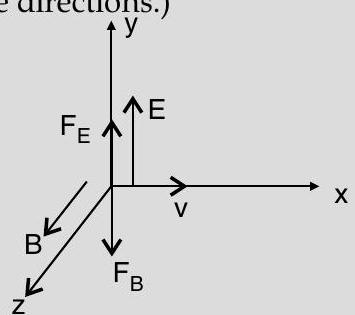moving-charges-and-magnetism Question 25
Question: Q. 1. Find the condition under which the charged particles moving with different speeds in the presence of electric and magnetic field vectors can be used to select charged particles of a particular speed.
R [O.D. I, II, III 2017]
Show Answer
Solution:
Ans. (i) For directions of
(ii) For magnitudes of
(i) The velocity

(ii)
[Alternatively, The student may write :
Force due to electric field
Force due to magnetic field
The required condition is
(Note : Award 1 mark only if the student just writes :
“The forces, on the charged particle, due to the electric and magnetic fields, must be equal and opposite to each other”)
[CBSE Marking Scheme 2017]
Detailed Answer :
If a charged particle travels in crossed electric and magnetic field, then both fields are perpendicular to each other.
Force on the particle will be :
As
Now to select a particle, making resultant force as zero, hence
Now,
Hence,
Hence,






